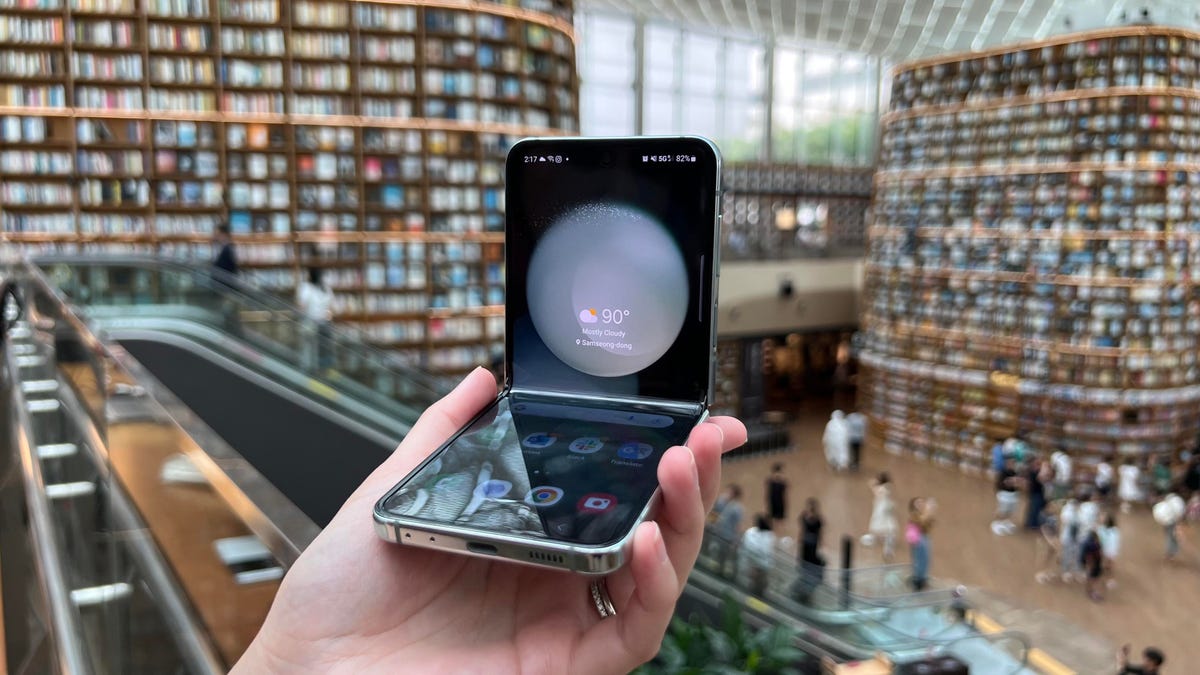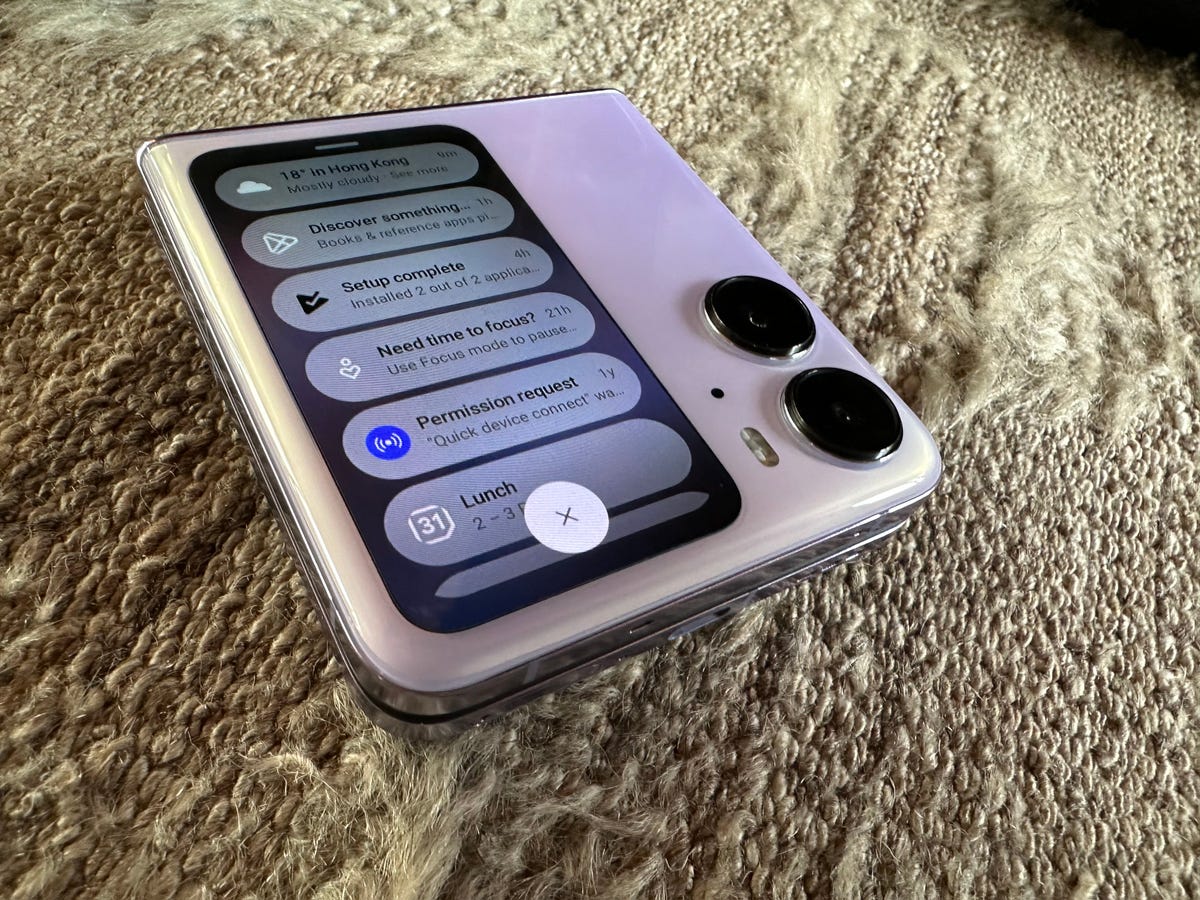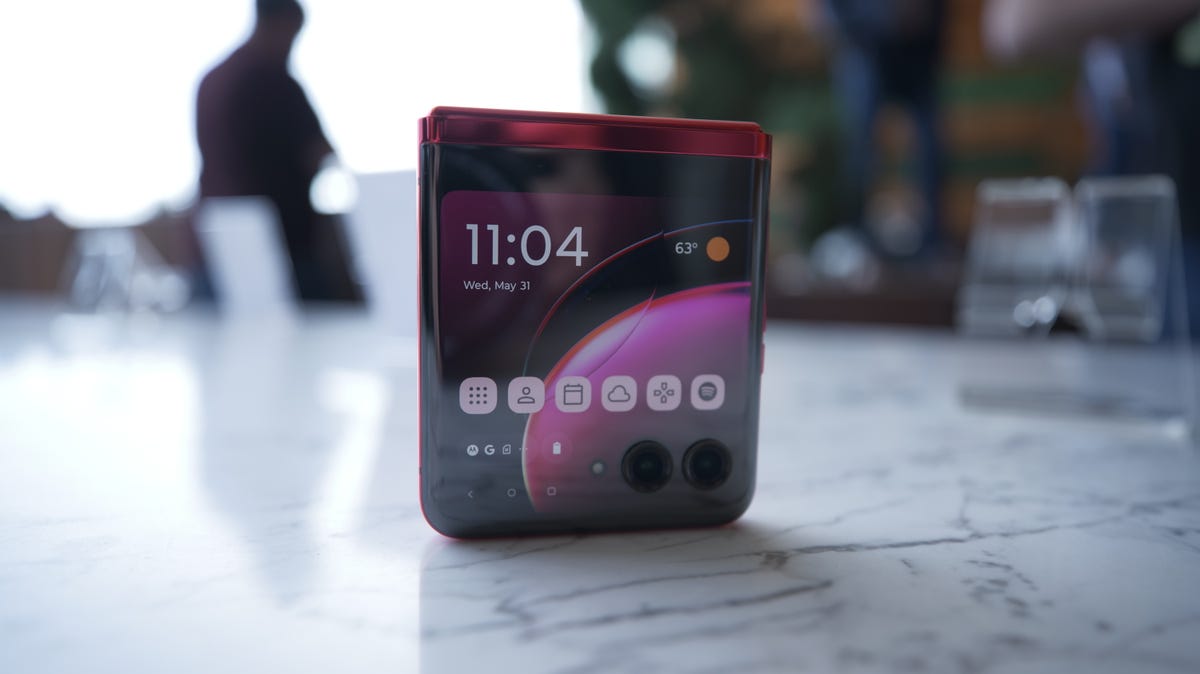Technologies
Comparing the Galaxy Z Flip 5, Razr Plus and Find N2 Flip: How Each Flip Phone Stacks Up
Samsung’s faces stiff competition from Motorola and Oppo. Here’s how the three foldable flip phones compare.

Samsung’s new Galaxy Z Flip 5, debuted at the company’s Unpacked event last week, revealing design changes that include a wider cover screen and a redesigned hinge. The new Z Flip 5 faces competition from Motorola’s Razr Plus and the Oppo Find N2 Flip, both of which use a similar flip-phone design combined with larger cover screens of their own.
The Galaxy Z Flip 5 has a new cover screen that extends across most of the phone’s front panel, except for a camera bump cutout. Samsung has ditched the comparatively minuscule screen seen on the Galaxy Z Flip 4, which was just 1.9 inches vs. 3.4 inches on the Z Flip 5. This change lets you use certain apps and widgets without having to open the phone, and it’s large enough to accommodate a full keyboard, allowing you to send a quick text.
Unlike the Razr Plus, which allows for nearly any Android app on its cover screen, Samsung takes a more curated approach by only allowing apps and widgets that are tailored for use on its smaller screen. Some of the supported apps include YouTube and messaging apps like WhatsApp. Other apps can only be used when the Z Flip 5 is unfolded. Whichever approach you prefer will likely come down to personal preference, but more apps could make their way to the Z Flip 5’s cover screen later this year.

Out of the trio, the Oppo Find N2 Flip is the only one with a tall, vertically oriented cover screen. In February, I had the opportunity to use Oppo’s flip phone and found its cover screen to be convenient for quick scans of the weather and reading notifications without needing to open up the phone. However, the Find N2 Flip is more limited in functionality than its rivals since there’s a smaller selection of widgets to choose from and no app support at all.
Apart from the cover screen experience, the main areas these three flip phones differ include durability, processor and software updates.
The Galaxy Z Flip 5 has an IPX8 rating for water-resistance, meaning it can withstand water submersion up to 1.5 meters (roughly 5 feet) for 30 minutes. As impressive as that is, it lacks dust-resistance. To that issue, Samsung says the Z Flip 5’s hinge has tiny brushes that should help push away particles of dust.

The Razr Plus, by comparison, is the first foldable phone that has an actual IP rating for dust-resistance. It has a rating of IP52. The first digit, refers to dust protection, and the second digit refers to water-resistance. Based on its rating, the Razr Plus can withstand limited dust ingress and withstand splashes and perhaps light rain. It can’t handle immersion, however.
The Z Flip 5 uses the newest and fastest processor of the three, running on Qualcomm’s Snapdragon 8 Gen 2 for Galaxy chipset. The Razr Plus instead uses last year’s Snapdragon 8 Plus Gen 1. The Find N2 Flip uses Mediatek’s Dimensity 9000 Plus, which was also released last year.
All three devices run on Android 13, with the Z Flip 5 and Find N2 Flip offering four years of software updates. Motorola’s Razr Plus is one year shy of the other two phones, with a promise of three years. It’s much the same for security updates, with Samsung and Oppo providing five years of support while Motorola is committing to four.
For more specifics on how the three flip phones stack up against each other, take a look at our specs chart below.
Galaxy Z Flip 5 vs. Razr Plus vs. Find N2 Flip
| Samsung Galaxy Z Flip 5 | Motorola Razr Plus | Oppo Find N2 Flip | |
|---|---|---|---|
| Display size, tech, resolution, refresh rate, brightness | Cover: 3.4-inch AMOLED (728 x 720 pixels); internal: 6.7-inch AMOLED (2,640 x 1,080 pixels), 1-120Hz | Cover: 3.6-inch OLED (1,066 x 1,056 pixels); internal: 6.9-inch (2,640 pixels x 1,080) | Cover Screen: 3.26-inch AMOLED; Main Screen: 6.8-inch AMOLED (120Hz), 2520×1080 pixels |
| Pixel density | Cover: 306 ppi, Internal: 425 ppi | Cover: 413 ppi, internal: 413ppi | Cover: 250ppi, Internal: 403ppi |
| Dimensions (inches) | Open: 6.5 x 2.83 x 0.27 in; closed: 3.35 x 2.83 x 0.59 in | Open: 2.91 x 6.73 x 0.28 in; closed: 2.91 x 3.48 x 0.59 in | Open: 2.96 x 6.54 × 0.29 in; Closed: 2.96 x 3.37 × 0.63 in |
| Dimensions (millimeters) | Open: 71.88 x 165.1 x 6.89 mm; closed: 71.88 x 85.09 x 14.99 mm | Open: 73.95 x 170.83 x 6.99 mm; closed: 73.95 x 88.42 x 15.1 mm | Open: 75.2 mm x 166.2mm × 7.45mm Closed: 75.2 mm x 85.5mm × 16.02mm |
| Weight (grams, ounces) | 187 g (6.6 oz) | 189 g (6.64 oz) | 191g (6.73 oz) |
| Mobile software | Android 13 | Android 13 | Android 13 |
| Camera | 12-megapixel (main), 12-megapixel (ultrawide) | 12-megapixel (main), 13-megapixel (ultrawide) | 50-megapixel (main), 8-megapixel (ultrawide) |
| Front-facing camera | 10-megapixel | 32-megapixel | 32-megapixel |
| Video capture | 4K | 4K | 4K |
| Processor | Snapdragon 8 Gen 2 | Snapdragon 8 Gen 1 | Mediatek Dimensity 9000+ |
| RAM/storage | 8GB + 256GB/512GB | 8GB + 256GB | 8GB/12GB +128GB/256GB |
| Expandable storage | None | None | None |
| Battery | 3,700 mAh | 3,800 mAh | 4,300 mAh |
| Fingerprint sensor | Side | Side | Side |
| Connector | USB-C | USB-C | USB-C |
| Headphone jack | None | None | None |
| Special features | 5G-enabled, IPX8 water-resistance, 25W wired charging, wireless charging, wireless power share, dual SIM | IP52, 5G-enabled, 30W wired charging, wireless charging, largest flip phone cover screen | 5G-enabled, dual sim, bundled charger, 44W charger |
| US price off-contract | $1,000 | $1,000 | Not in the US. Starts at £849 which converts roughly to $1,080 |
Technologies
Live-Action ‘Call of Duty’ Movie Reportedly Being Co-Written by Taylor Sheridan
The Yellowstone co-creator will reportedly team up with Peter Berg on the Paramount film.

Yellowstone, Landman and, now, Call of Duty. Taylor Sheridan, co-creator of the aforementioned hit shows, will co-write Paramount and Activision’s upcoming live-action video game adaptation, according to a report from Variety on Thursday.
Peter Berg will also co-write and direct the movie, which was announced last month. Berg previously directed films including 2018’s Mile 22, 2012’s Battleship and 2013’s Lone Survivor, while Sheridan’s movie credits include 2016’s Hell or High Water and 2017’s Wind River. Berg, Sheridan and David Glasser will produce the Call of Duty film.
Don’t miss any of our unbiased tech content and lab-based reviews. Add CNET as a preferred Google source.
Call of Duty is a first-person shooter military video game series that debuted in 2003. CNET senior writer David Lumb calls it «arguably the biggest shooter franchise in gaming, with millions of players picking up every year’s new entry to the series.»
Lumb said the franchise is known for its bombastic single-player campaigns, which feature globe-spanning plots that rival those of the Mission Impossible films. «A Call of Duty movie has a lot of material to draw from,» Lumb said.
He also noted that Berg’s direction of Lone Survivor would fit the grim military heroism of Call of Duty, while Taylor Sheridan’s spate of neo-Western films and shows could lend a frontier adventurism to the film.
«Their collective works seemingly harmonize with the jingoistic pro-military tune of Activision’s shooter franchise — which is probably a good thing for Call of Duty fans,» Lumb concluded.
A release announcing Paramount and Activision’s film deal teased that it’ll be «designed to thrill its massive global fan base by delivering on the hallmarks of what fans love about the iconic series, while boldly expanding the franchise to entirely new audiences.» It didn’t include cast or plot information.
The update follows recent news that Sheridan is leaving Paramount for NBCUniversal. Paramount did not immediately respond to a request for comment.
Technologies
US Government Urges Total Ban of Our Most Popular Wi-Fi Router
Technologies
Animal Crossing Update Adds Lego Furniture, With a Switch 2 Version Arriving the Same Day
Fans of Animal Crossing will have a reason to go back to their island.

Animal Crossing fans just received a big surprise, and it’s not just a new content update. A Switch 2 version is on its way.
Animal Crossing: New Horizons will receive its first big update in three years, according to a post from Nintendo on Thursday. The update, labeled 3.0, will roll out on Jan. 15, the same day the Switch 2 version of the game will be available for purchase.
Released for the original Switch back in 2020, New Horizons was the first Animal Crossing game to come to a Nintendo console since 2008’s Animal Crossing: City Folk for the Nintendo Wii.
Nintendo regularly updated New Horizons for two years after its release, but stopped at update 2.0.6 released in November 2022. Two updates were added earlier in the year to prepare the game for playability on the Switch 2.
Animal Crossing 3.0 Update
In the 3.0 update coming on Jan. 15, a new hotel is opening. Players can help bring in guests to stay at the hotel by decorating guest rooms and dressing up mannequins to sell resort clothing.
For those who haven’t touched New Horizons in years, a Reset Service will be available. Players can have their island cleaned up, and items can be stored away or trashed for those who want a clean slate.
Players with a Nintendo Switch Online membership will have access to up to three islands, where they can explore and do as they please. These new areas are available on Slumber Island. It’s up to the player to decide how the island will look, what items or plants are on it and even which characters will be found on the island. Players can also invite friends to build it together.
New Horizons will feature special collaborations and Nintendo retro gear. Lego items will be available in the update for players to decorate their homes with or clothing to dress up their villagers with. Retro Nintendo consoles, such as the NES and Game Boy, can also be used as decorative items.
If the player has a Switch Online subscription, some classic titles such as Ice Climbers and Dr. Mario can be played via these in-game devices. There are also special items based on The Legend of Zelda and Splatoon series when players tap their amiibo from those games onto the Switch while playing.
Animal Crossing: New Horizons on Switch 2
Switch 2 owners can get in on the digital life game with Animal Crossing: New Horizons — Nintendo Switch 2 Edition. Not only will this new version come with updated graphics, including 4K resolution in TV mode, but it will also add special features that can only be done on the newest console.
One of the features is mouse controls for the Joy-Con 2. Players will be able to use the controller as a mouse to decorate indoors, create custom designs and write handwritten messages for the bulletin board.
Residents in the game can now be found by saying their name into the Switch 2’s built-in microphone while using the megaphone in the game. Multiplayer has also improved dramatically, with 12-player sessions available for those playing on the new edition, and CameraPlay is supported to allow players to see one another.
Animal Crossing: New Horizons for the Nintendo Switch 2 will be available for purchase on Jan. 15 for $65. Owners of the original Switch version of New Horizons can upgrade to the Switch 2 version for $5.
-

 Technologies3 года ago
Technologies3 года agoTech Companies Need to Be Held Accountable for Security, Experts Say
-

 Technologies3 года ago
Technologies3 года agoBest Handheld Game Console in 2023
-

 Technologies3 года ago
Technologies3 года agoTighten Up Your VR Game With the Best Head Straps for Quest 2
-

 Technologies4 года ago
Technologies4 года agoVerum, Wickr and Threema: next generation secured messengers
-

 Technologies4 года ago
Technologies4 года agoBlack Friday 2021: The best deals on TVs, headphones, kitchenware, and more
-

 Technologies4 года ago
Technologies4 года agoGoogle to require vaccinations as Silicon Valley rethinks return-to-office policies
-

 Technologies4 года ago
Technologies4 года agoOlivia Harlan Dekker for Verum Messenger
-

 Technologies4 года ago
Technologies4 года agoiPhone 13 event: How to watch Apple’s big announcement tomorrow
